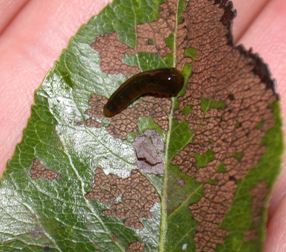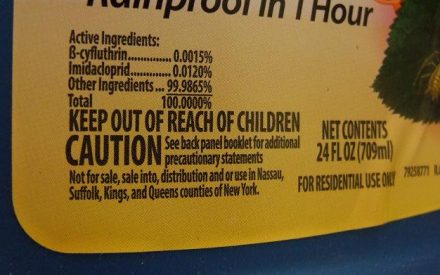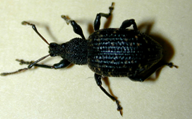
Phil Pellitteri, UW Insect Diagnostic Lab
Revised: 12/30/2010
Item number: XHT1200
Pear slugs are not true slugs (see University of Wisconsin Garden Facts XHT1040), but are larvae of the pear sawfly (Calora cerasi). These larvae feed and cause damage on many kinds of ornamentals and fruit trees, including cherry, cotoneaster, mountain-ash, pear, purple leaf plum and serviceberry.
Appearance: Pear slugs (larvae) are dark green to orange in color, tadpole-shaped and grow up to ½ inch in length. They have a shiny appearance because they cover their bodies with their own slimy, liquid waste. Pear sawflies (adults) are shiny-black, thick-bodied, stingless wasps that are ⅛ to ¼ inch long with ¼ to ⅜ inch wide wingspans.
Damage: Pear slugs feed on the upper surface of leaves, and typically avoid feeding on lower leaf surfaces. When feeding, pear slugs eat the tissue between leaf veins, but leave the veins themselves intact. This feeding pattern is known as skeletonization and gives leaves a lacy appearance. If feeding is extensive, leaves may brown and shrivel. In general, damage from pear slug is cosmetic and will not harm the overall health of a plant.
Life Cycle: Pear sawfly adults emerge from overwintering cocoons in late June through July, and subsequently insert eggs into the upper surface of leaves of preferred hosts. The eggs hatch and the resulting pear slugs (larvae) feed for two to three weeks. Larvae pupate in the soil and a second generation of adults appears and lays eggs in August through early September. The resulting larvae then feed for two to three weeks and overwinter as cocoons in the soil.
Control: Pear slugs often complete their feeding long before gardeners notice that leaf damage has occurred. Therefore, before considering any treatments, make sure that larvae are present on plants. Pear slugs are easily killed with insecticidal soap, neem oil, bifenthrin, carbaryl, malathion, permethrin, spinosad or other general landscape insecticide sprays. Pear slugs are not controlled by bacterial products containing Bacillus thuringiensis (Bt). Soil drenches also are not effective for controlling this pest.
For more information on pear slugs (pear sawflies): Contact your county Extension agent.
Download Article





 Roseslug Sawfly
Roseslug Sawfly Home Fruit Insecticides
Home Fruit Insecticides Degree Days for Common Landscape Insect Pests
Degree Days for Common Landscape Insect Pests


